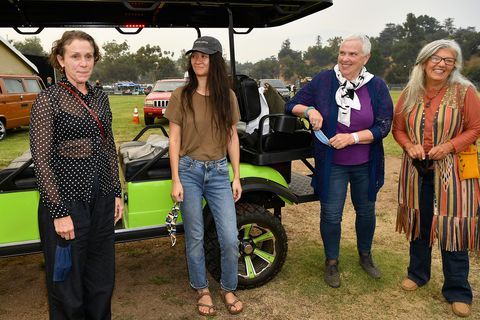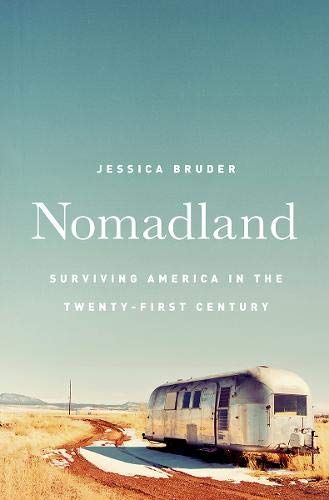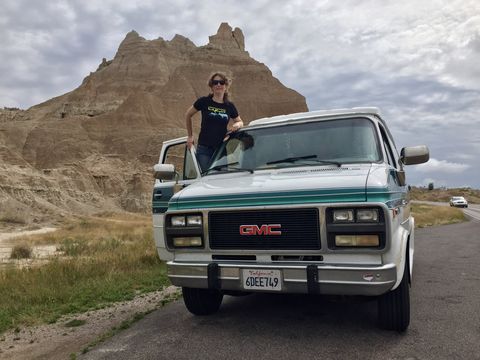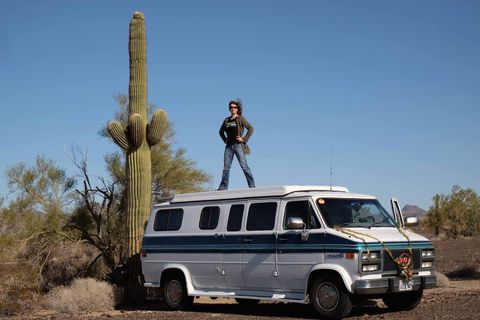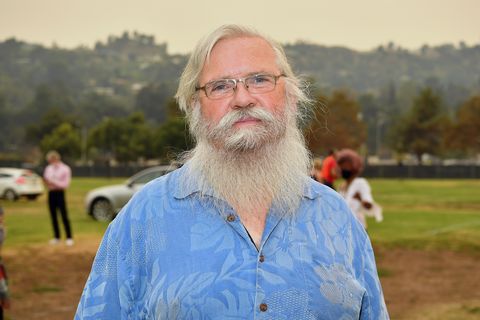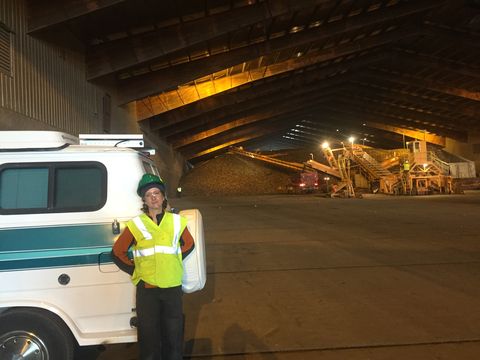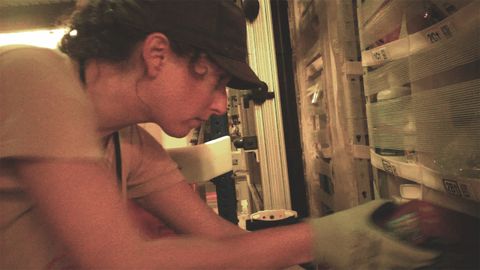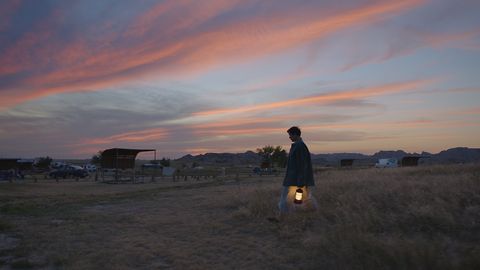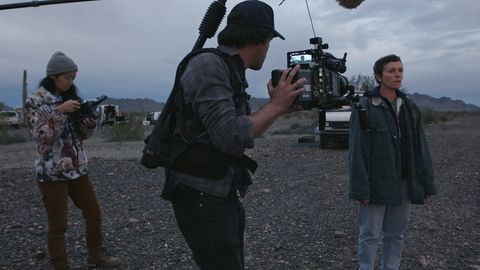When Jessica Bruder was reporting Nomadland, her award-winning gonzo investigation of transient American seniors who follow seasonal employment while living out of their vans, she never imagined that the nomads with whom she was up to her elbows in campground toilets would become movie stars. Yet here we are, almost four years out from the book’s publication, and Nomadland has become a feature film: an awards season darling directed by Chloe Zhao, starring Frances McDormand as a fictional protagonist alongside the real-life nomads featured in Bruder’s book, who appear as themselves. For years, Bruder lived with and reported on these itinerant laborers, traveling the American West in her own van (christened Van Halen) and working grueling jobs alongside them everywhere from an Amazon fulfillment center to a sugar beet harvesting plant. Nomadland is a modern Grapes of Wrath, depicting the dystopian economic dispossession of an aging population for whom retirement is an out-of-reach dream.
Bruder’s book centers on Linda May, a 64-year-old grandmother living out of a secondhand Jeep who dreams of building a sustainable “Earthship” dwelling. Other nomads from the book who appear in the film are Charlene Swankie, an experienced kayaker who’s been living on the road for over a decade, and Bob Wells, a famous YouTuber and the founder of the Rubber Tramp Rendezvous (an annual gathering of vandwellers in Quartzsite, Arizona). In Zhao’s adaptation, McDormand plays Fern, a 61-year-old widow who embarks on the vandwelling life after the shuttering of Empire, the United States Gympsum Corporation’s company town in Nevada, where she and her late husband lived and worked. In her travels, Fern encounters many of Bruder’s real life nomads, including Linda, with whom she works at a campsite in the Badlands; Swankie, with whom she spends time in Arizona; and Bob, who pours his heart out to Fern at the Rubber Tramp Rendezvous.
At the conclusion of Nomadland, Linda had purchased acreage in Douglas, Arizona, where she intended to build an Earthship and live a homesteading lifestyle. Esquire spoke with Bruder about where the nomads featured in her book have ended up, as well as how life on the road has changed in just a handful of years.
Esquire: What did you think of the film adaptation of Nomadland?
Jessica Bruder: I loved it. Obviously I’m not a neutral viewer, of course. I’ve been to so many of the places that are in the film, reporting with people who are actually in the film, so the feeling of déjà vu is overwhelming. In the very first scene, Fern hugs a gentleman I reported with about seven years ago. For me, it was incredibly poignant, and I thought they did a fantastic job with the emotions of the landscape. I just loved it. Seeing Swankie and Linda and Bob on the big screen doing so well, telling versions of their stories, and being validated was really exciting.
ESQ: I found it so wonderful and surprising to actually see Swankie, Linda, and Bob playing themselves. What do you know about how that came to be?
JB: Chloe Zhao has a tradition of working with non-actors. In a strange way, the challenge wasn’t how to work with non-actors, but rather how to integrate Frances McDormand. I remember Chloe joking with me that she figured she’d be saying, “Linda, that’s great”, and, “Frances, act less.” That said, nothing was definite. I remember when Chloe first asked me if I thought that Linda would be good on camera, and my response was, “I don’t know what makes someone good on camera.” I do know what made her a great subject for the book, as she’s someone I followed for about three years—what made her a great subject was that she didn’t ever turn it on for me. She never turned it on when I was recording her and following her around like a lost duckling. The way she was with me was the way she was with everybody, whether it was people at a campsite or people on the job elsewhere. That unselfconsciousness made her really wonderful to follow, because she did not have a lot of pretense and was comfortable in her own skin. Those are things that I imagined and hoped would translate well to being in front of the camera. I introduced Chloe to Linda, and they really hit it off.
ESQ: What makes Linda such a compelling subject in your book—it completely came across in the film. Her warmth, her generosity, her cheer—it’s all there. It was fun to see that person I fell for on the page come to life as her real self on the screen.
JB: Linda is Linda, no matter where she goes. She’s remarkably unselfconscious, and from a writer’s perspective, she’s a quote machine. I love the way she holds herself. I love the way she talks. I’m thrilled for other people to see more of that, because it was wonderful for me when I followed her around for three years.
ESQ: What was the extent of your involvement with the film?
JB: I don’t know how this usually goes, because this is my first rodeo, but formally I was a consulting producer. I wanted to help, so I sent Chloe a lot of research that didn’t make it into the book. I had a ton of material on Empire and how it used to look, as well as additional material on people I’d worked with. At some point, someone wanted to hear how people they were considering for casting sounded, so I sent them some interview material. I also made a lot of introductions, which is scary because Chloe seemed incredibly talented, but when you’re making these introductions, you want to feel you’re sending your subjects into good hands.
I was not the screenwriter, though; Chloe was the screenwriter. I was an extra on the set for about a week in Arizona, and that was a trip. I was out there with my van, and they were recreating the first Rubber Tramp Rendezvous I went to, which was back in 2014 before it was thousands of people. Back then, it was around 75 people, but they didn’t want to take attendance, because if it hit 75, they’d actually have to pay for a permit. This all seems comical now, because it’s gotten so much larger.
ESQ: So you still have Van Halen?
JB: I do. I was supposed to go to Reno for some Nevada speaking gigs in April 2020; I had the van staged and ready to go in a friend’s backyard. It hasn’t moved since then, and it had already been sitting there for about six months. My friends are taking care of it for me, but I’m really eager to get back to the van when the world allows that.
ESQ: I’m reminded of something you wrote in the coda of the book: “The story keeps unfolding into the future, but at some point you step away.” Have you managed to step away since the book came out in 2017?
JB: I’m still in touch with everybody, which is fantastic, particularly considering how things are continuing with the movie. When I was reporting the book, I wanted to see where people were going; years later, I still want to see where they’re going. It was definitely weird the first time that I didn’t attend the Rubber Tramp Rendezvous. I don’t think I’ve stayed unhealthily attached to it, but I’m not documenting people anymore—I’m just having conversations with them. At this point they feel more like people I’ve shared this crazy adventure with than they feel like subjects. If you consider that this went from a really random pitch to Harper’s, a publication I’d never written for at the time, and then it became a cover story, which became a book… none of this was guaranteed or assumed. I couldn’t have imagined it. Now it’s a movie, which is a total thrill. I know a bunch of people whose books were optioned but never made into movies, so I tried to take everything with a grain of salt. Then it happened, and it happened quickly. At this point, I feel like I’ve been on a wild ride with the people I was reporting on. It’s not so much of a source relationship anymore; it’s a friendship forged in really odd circumstances.
ESQ: What have you heard from Linda, Swankie, and Bob about what it was like to be movie stars?
JB: Linda got such a kick out of it. I remember talking to her when she was heading to the set at Wall Drug. If you’re living in a van or trailer, you don’t have a bathtub. She would often take showers at different places. When she checked into the hotel for the shoot, she was super stoked about the bathtub. She sent me a picture of her dog, Coco, sitting in the bathtub. She also sent me a picture of her and Frances sitting at Wall Drug. It was really cool because, towards the end of the book, I went out to Arizona and showed her the land she purchased via video chat. I was her Mars Rover in that way, transmitting information back to her. When she went into movie land, she became my Mars Rover.
I remember her being a little overwhelmed by how it is when you’re on set and everybody is constantly after you. Do you need this? Do you need water? Do you need a chair? Linda is so used to doing stuff on her own that I think being attended to in that way was hilarious at first, and then enjoyable. That was a kick in the pants. She was the person I was in touch with most closely during filming.
ESQ: Speaking of Linda’s land—what can you tell us about what progress she’s made homesteading on her land and achieving her dream of building an Earthship?
JB: After I finished the book, I went back to Linda’s land with my best friend, Dale Maharidge. Dale was the person I would call in the middle of the night when I was reporting and wondering if this was really a story. He and I took the van and headed out to Douglas, Arizona to meet up with Linda and her friend Gary. She had built the PVC frame for a really big greenhouse, because she was planning to homestead. We helped her put a giant sheet of plastic on and attach it on both sides of the pipe; we also helped her with some jobs that were better with more hands. It was really a blast, being out there working with her—working for her. She knew exactly what she wanted. We were just the muscle.
This content is imported from YouTube. You may be able to find the same content in another format, or you may be able to find more information, at their web site.
It gets really hot in Douglas. When Linda came back after being away, the PVC structure had melted. It’s a very common structure to use for greenhouses; it’s not like she made a mistake or did something exotic. She had a swamp cooler set up, and we’d helped cut a vent, but climate control was really difficult. She figured that maybe this wasn’t her forever piece of land. She donated it to the Homes on Wheels Alliance, which is a nonprofit Bob started to help nomads in need. They were hoping to use it as some sort of way station for people who are new to the road. With money from the film, she ended up buying a patch of land outside of Taos and is currently homesteading there with a few friends. She hasn’t built an Earthship; what she’s really focused on now are some interesting greenhouse ideas. Dale and I, as well as half of the film crew, volunteered to go out and pound tires to help her build an Earthship, but it’s just a huge undertaking, and after the past few years, Linda may be ready to chill out just a little bit. Right now she’s focusing on smaller projects, which I think is great. Whatever makes her happy. She’s doing sustainable building planning, and she’s good. Seeing that has been pretty fantastic.
ESQ: How do you anticipate that this might change her life? Will she go back to the Rubber Tramp Rendezvous and be welcomed as a hero? How is the community going to receive this film, and the involvement of people like Linda?
JB: I think people are into it. When the film was being shot near the Rubber Tramp Rendezvous, the actual Rubber Tramp Rendezvous was also happening. Talk about a mindfuck. We were recreating the 2014 tiny Rubber Tramp Rendezvous while the one with thousands of visitors was also starting up. After being on set for the fake Rubber Tramp Rendezvous, we went over to the real one. Everybody was wearing name badges. They put something silly on mine, like “Word Slinger.” On Linda’s, they put “Star.” She actually took it back and asked for one that just had her name on it. I don’t think she really wanted that kind of attention. She certainly doesn’t court it, but I think that community has been supportive. When you consider that Bob Wells, who started the RTR, has such a big role in the film, I think everybody’s rooting for them.
ESQ: In the years since the book came out, so much about the world has changed, yet so much remains alarmingly the same. Of course, the elephant in the room is the pandemic. How has the pandemic affected American nomads? Have they been uniquely imperiled?
JB: It’s horrible to be sick when you’re on the road, particularly if you’re out there solo. Silvianne, who’s in the book, told me that she had COVID and convalesced in her van. That really doesn’t sound like fun at all. But it’s funny—a lot of people I talked to fared better than I expected, because so many of them are staying in remote places and are introverts to begin with. That was a strange advantage. They could also drive to wherever COVID cases were lower, if they wanted to. But I think the craziness with the economy, and particularly if this eviction wave happens, could flood the ecosystem that they live in, which could make things more difficult. Bob even shared a video on his YouTube channel about what to do if you get evicted from your house and you’re moving into a house on wheels. Right now, everybody has their favorite spots, and people want to be able to do stealth parking in cities sometimes, which is staying overnight and remaining undetected. The more people doing that, the harder it may become for people to stay below the radar. At the same time, what was happening during the book is still happening: there are so many cities essentially criminalizing houselessness and making it a crime to sleep in your car. You have that pressure going both ways.
ESQ: Has the pandemic affected nomads’ employment prospects?
JB: I don’t know anybody who lost a job, but I read the forums online and I’ve heard that some employers are hiring fewer people. I’m sure people were impacted in that way, because a lot of national parks and campsites were closed too. For people who like to stay in parks, that was challenging. Where can you go? The landscape totally shifted. There were websites for nomads that had ongoing lists tracking which parks were open and which parks were closed, because it was an ever-evolving situation that became a patchwork. Some nomads stayed with friends or leaned on people they knew who didn’t mind them riding out the pandemic by parking near a house.
ESQ: I’ve been thinking about Amazon’s CamperForce, as there’s been so much excellent reporting about the terrible conditions in Amazon fulfillment centers during the pandemic. Has the CamperForce been affected by those unsafe practices?
JB: I don’t know anybody currently in CamperForce. There’s a lot of attrition, so people I knew doing the job a few years ago are no longer doing it. But when I was there, the same safety standards that applied to full-time Amazon workers also applied to CamperForce workers. There was really no distinction made. I know that Amazon is still employing CamperForce workers; In fact, when their map was online during the hiring period, they were hiring for more states than I’d ever seen, which I thought was remarkable. I’d imagine CamperForce workers are dealing with whatever other workers are dealing with.
People often ask me: why don’t these people unionize? I think the thing that’s often overlooked is that these are people doing transient jobs; they’re plug and play labor. They’re there and then they’re gone. So many of them are used to ageism in the workforce, and because they’re a little older, it’s a different generational attitude. A lot of people feel that they should be grateful to have the job. Even if they didn’t feel that way, they’re not around long enough to organize. While I think unionization spillover would impact the CamperForce, I never expected them to be leading the charge on anything like this.
ESQ: Your book is largely about retirees, but in the years since Nomadland was published, the hashtag “#vanlife” has taken off. Have you followed this movement?
JB: Van life cracks me up. If you want a quick laugh, Google “#vanlife and guilty subconscious”; there’s a parody song about #vanlife that’s just sublime.
This content is imported from YouTube. You may be able to find the same content in another format, or you may be able to find more information, at their web site.
Honestly, I feel like #vanlife is more of a brand than a movement at this point. I think there are people out on the road doing their thing, but I also think there’s a slice of Instagram influencers actually managing to find sponsorship for their lifestyle. That’s such a small, aspirational place to be. It’s easier to talk about how you’re into minimalism than to discuss how the job market sucks, and student loans are real, and the federal minimum wage is flat. A lot of those forces at work on older folks in the book are also at work on younger generations. It’s hard to get a good job now; the price of housing keeps climbing, as well. But we as a culture are really into positivity, which sometimes becomes what I like to call weaponized positivity. I think it’s great that people are doing their thing, but this branded experience is basically a little atoll of fashion in a landscape that’s much more complicated. It’s extracting the most photogenic and aspirational aspects of this lifestyle, thereby making everybody feels like they should be living this way, when it’s really just a few people.
ESQ: To your knowledge, do these young influencer types mix at all with the nomads you knew? Do they go to the Rubber Tramp Rendezvous?
JB: There were so many people at the Rubber Tramp Rendezvous; there could have well been influencers there. The population has probably become more balanced between younger people and older people in the years since I first attended. You definitely see a lot of people who have painted “follow our blog” on their vehicles. The thing that really makes me roll my eyes are people who are sponsored. Plenty of people would love to live off their blogs, but are combining it with other forms of employment.
ESQ: So is it possible to get rich on #vanlife?
JB: I don’t know anyone who’s done it, but you see a few people out there painting very glossy pictures. Either they were wealthy before or their sponsorships have taken off. I roll my eyes at all of it.
ESQ: What those glossy pictures leave out are the gritty realities you capture in the book, like using a bucket in the van as a toilet.
JB: I was thrilled that the Nomadland movie included that. I thought it was pretty remarkable how the movie captured the gritty realities of living on the road. Meanwhile, on the actual road, I remember when Swankie was out at a gathering of nomads, and they were all sitting around the campfire. These were people who were in these shiny new rigs; they may have been vacationers who lived part-time on the road. They said, “Where’s your rig? What do you live in?” She pointed to her van, and apparently they left their own campfire, which is nuts. Even in this small community, you have class hierarchies. It’s really sad.
ESQ: There’s a section late in the book where you consider how your white privilege shaped your experience when you tried out van life. You write, “In an era when unarmed African Americans are getting shot by police during traffic stops, living in a vehicle seems like an especially dangerous gambit for anyone who might become a victim of racial profiling.” Since you published this in 2017, racist terror and violence have continued to escalate. Has it become more unsafe to be a nomad of color?
JB: What I know is that there are people pushing to show the culture that you can be a person of color on the road. I’ve seen more people out there who are blogging and talking about it. I actually met a woman on the set with whom I talked long hours about this. She told me that at one point, she was stranded in the desert, and everybody back home was worried about her. She tried to explain to them, “It’s just like on the block. I’m going to wait for people to wake up and then somebody will jump my car.” I think people are trying to bridge worlds, but it’s not just people who are Black If you think about Latinos getting hassled on the border, and the fact that there are inland checkpoints, which aren’t really on the border, people will be profiled there.
I think it’s absolutely understandable that people are reticent. I think the arbitrary cruelty and monstrosity of what happened to George Floyd definitely put that to the forefront of the conversation, even though it was a pretty big deal before. I haven’t heard of a person of color living in a van and being shot by a police officer; I’m glad not to have an example of such a horrible thing. But I can see how people might be more reluctant to try living on the road if they are more vulnerable to brutality.
Get 87 Years of Award-Winning Journalism, Every Day
Join Esquire Select
ESQ: A lot of this book takes place in Trump country. States are not monoliths, of course, but many of the states that people pass through in the book are states that voted red. To your knowledge in the years following the book, how have the divisions in the country affected or divided the nomad community, if at all?
JB: Most of the times when I was around people, they were not talking politics. It was a less fraught time, but I didn’t see a ton of politicking online either. I attribute that to a few things. One is that when nomads get together, there’s often a tacit agreement not to talk politics. In a weird way, they’re post-political in that they have lost faith in the quote unquote system; they don’t think the cavalry is coming anytime soon. They don’t think they can have that much of an impact on government. It doesn’t matter who’s in the White House. I know people who would say, “Same puppet; different hand.”
People are getting social security and other government benefits, of course; if that stopped, they would be screwed. But I think there’s a way in which they almost feel a bit outside of it, to be honest. Once you’re living in a van, it’s like you’re off the grid. I think people feel a bit disconnected. Some people do vote. I remember Lavonne voted for Hillary, and was talking about it online. But often the community can’t even do that, because if you have a fake address, which just about everybody has to, or the address of a mail forwarder, it’s quite likely that the address won’t be in the state where you’re located when the polls open. People on the road are often disenfranchised.
ESQ: Toward the end of the book, you turn the lens to Brooklyn, writing about how people are stealth-camping in Red Hook. Have you seen that trend continue to rise in American cities?
JB: Absolutely. I’m someone who lives in Brooklyn, so I’ve seen more of it in Brooklyn. I remember at the beginning of COVID, in an area where I hadn’t seen people before, there was an RV, a trailer, and people who had set up camp there. There are people under overpasses. There are a lot more vehicles than I’ve seen before. We get all the reports from California, where an interesting and very sad thing is happening. A lot of people who have stationary, reliable jobs are unable to afford housing. They’re not hitting the road; they’re just moving into vehicles that are parked in the same areas and commuting to work. You essentially have a steel tent. Urban nomads are definitely on the rise.
This content is created and maintained by a third party, and imported onto this page to help users provide their email addresses. You may be able to find more information about this and similar content at piano.io



